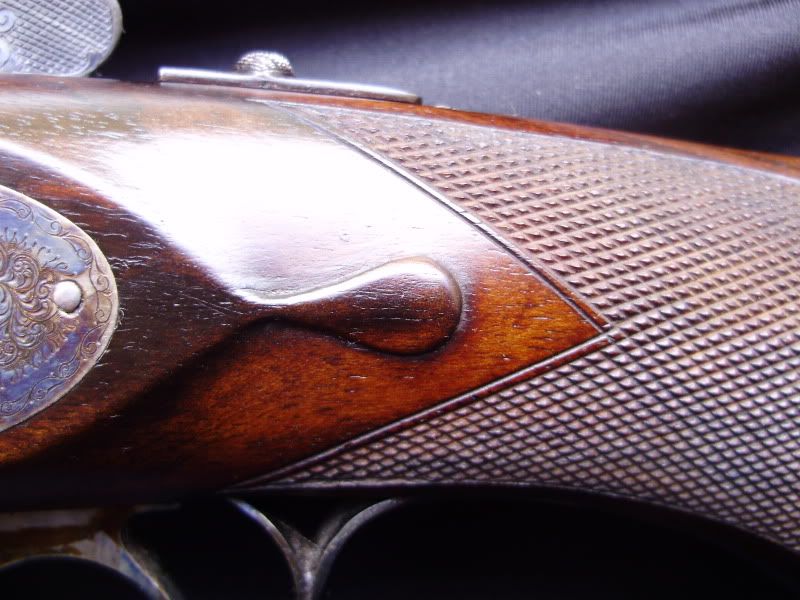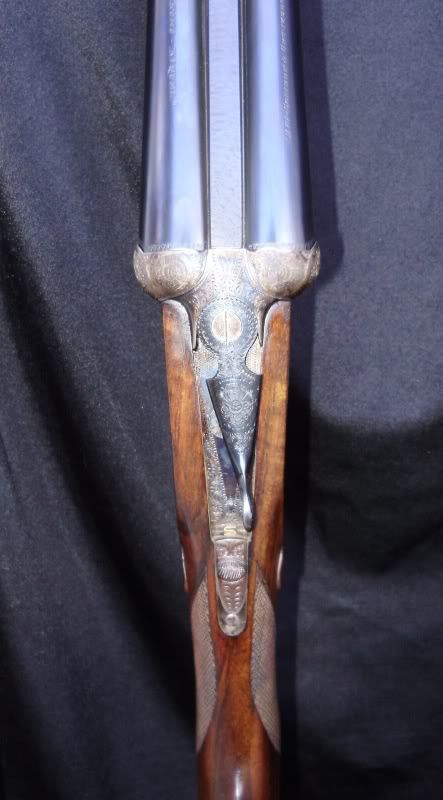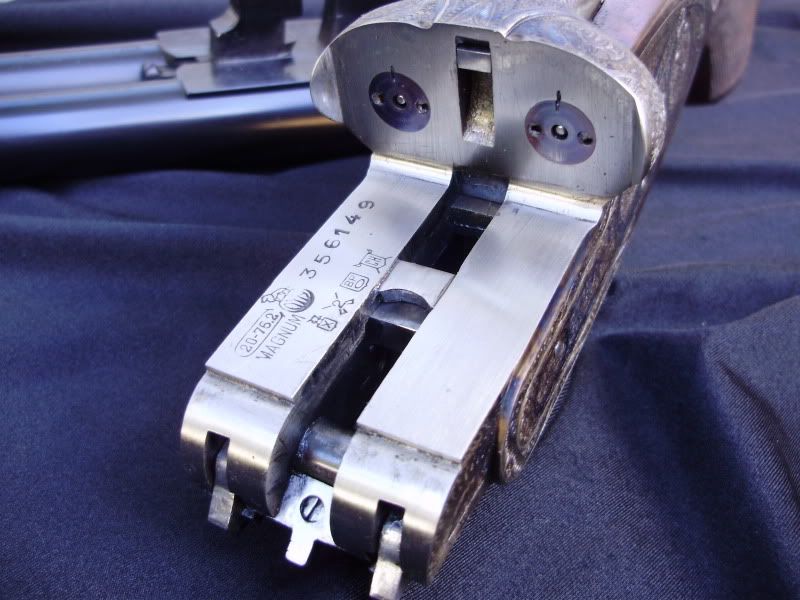Hi fellas,
I've an acquaintance who is looking at a matched pair of AYA Model 56s' in 12 ga. mftr. in 1968. He asked me about the metallurgy coming out of Spain during that period; of which I know nothing other than what I've read in the past stating some of it could be rather metal 'soft' when it came to wear vs. high volume shooting. Any truth to that? The guns do have sideclips and a Purdey-style hidden third fastener on 30" barrels bearing 2-3/4 oz. proofs, which is all to the good if fitted up properly. We'd sure appreciate any knowledgable opinions, as I've little experience with the Spanish stuff.
Thanks in advance,
rob
In 1967, my buddy and I pooled our money and imported five 20-gauge 26-inch straight grip, H&H sidelock doubles, with hidden third fastener, made by Eusabio Arizaga, from their exporter Laurano Villar. This brainstorm came about because of all the praise Jack O'Connor was heaping on his Eusabio Arizaga. We sold three and each kept one. Wayne's was gone in six months. I was hard headed and kept mine through two new hammers in the right hand lock. The original and the first replacement both crystalized and broke. When the second replacement was installed, my gun also flowed down the river of commerce, and I've never messed with a Spanish gun since.
Yep, any gun built anywhere to a low price point is bound to be poor.
A 30KUSD+ Arrizabalaga is a superb gun and worth every penny.
My 2002(?appx) AyA 20 ga has had many, many thousands of rounds thru it at clays and many hundreds at upland birds and the only problem was a broken left barrel striker. Ho-hum.
I shoot a number of Spanish guns from your era regularly and have never had a problem. I suspect that if a gun has been used and is still going strong after some 30 years it has no "soft steel" problems. It would be dead by now.
Anyway, my own personal feeling based on using and working on Spanish SxSs is that the bad steel is largely a perpetuated rumor based on some really cheap guns imported to a price point and they should never have been made.
In the late '60s I bought a no-name .410 Spanish double in a store in Macon, Ga out of a wooden barrel filled with them. Through the years I heard all about poor Spanish steel, but that little .410 is still around and shooting. I'm sure a lot of them were bad, but my experience was just fine...Geo
I have a Holland model 28 ga Ugartechea from that period and it has given great service with no problems and is still tight and on face. Bobby
'Thanks' to all so far for your input, especially Adam's that is specific to the Model 56. Some of the bad press I had read came from the late Don Zutz, but considering that he hunted upland birds most all of his life without a dog, that should have told me something. Just kidding......but not about our appreciation to those of you who have responded.
rob
The 'soft steel' was in the innards; not the frames or barrels. Eusubio Arizage made some fine guns and probably like other good makers of that time got a batch of lock parts not hardened properly from the same supplier many makers used. I believe the better makers were more vigilant, but some soft parts slipped through. You hardly ever find a Spanish gun with the lever left of center.
I've got an Uggie boxlock. I think the code translates to 1972, and while I have no idea where it spent it's first 30 seasons, it was used hard by somebody.
I've been busy getting the stock to fit me, and have fired a bunch of ammunition at clay targets and web paper roll ends to look at patterns, and can report nary a problem. Hell, I've been looking for problems and I can't find any. It has a Spanish "look" about it, but, has a well fitted hidden third fastener, and double underbites.
I really like disc set strikers, and had a spare set made and bought a tool. I'm already one up on a hunting buddie's Webley 700 that ate an integral hammer/striker on the first shot of pheasant season, even though it cost 10 times what my Uggie did. The Uggie was a lot of gun for $400.
Best,
Ted
In the early 60s, I guided duck and goose hunters on the missouri about 40 miles north of Omaha. The 3.5 inch magnum was just becomming popular in that part of the world. I remember 3 different brand names i.e. Zabala, Mercury and Dubois because we had all three. However, I don't remember a day when all of them were working at the same time. Not very good.
tight lines Jim Sears
In the early 60s, I guided duck and goose hunters on the missouri about 40 miles north of Omaha. The 3.5 inch magnum was just becomming popular in that part of the world. I remember 3 different brand names i.e. Zabala, Mercury and Dubois because we had all three. However, I don't remember a day when all of them were working at the same time. Not very good.
tight lines Jim Sears
Zabala, Mercury, and Dubois? Those guns were no where near the quality of #56 AYA. That's like comparing a Pinto to a Cadillac... both are American made but they're not in the same league.
Adam
Pardon me,Adam, I thought the man was looking for someone with some knowledge of Spanish metallurgy as it related to the gun industry from the 50s and 60s. I guess I misunderstood.
tight lines Jim Sears
Robert
In regard to the Model 56, it is an excellent live bird gun and was built as such, no corners were cut or tolerated. Many M56 shooters were professionals shooting for their livelihood who put their money on the table every time they stepped up to the line. Side by sides and double triggers were the rule on box bird guns used by European shooters of that time frame.
Pardon me,Adam, I thought the man was looking for someone with some knowledge of Spanish metallurgy as it related to the gun industry from the 50s and 60s. I guess I misunderstood.
tight lines Jim Sears
Jim, sorry for coming off a bit rude. I didn't mean to. I just want the gentleman to understand that the guns you mentioned are nothing like an AYA #56 in terms of quality.
Take Care.
Adam
The recent guns mentioned were made in the time frame.
I'm betting you never saw a Pinto...
I bet you still drive one...
Best,
Ted
I lost respect for Weiland's books when he alluded to the "problem" but never addressed it. I guess he either didn't know or was afraid to step on any toes. A pity, since there were occasional tidbits of information in his writings.
I didnít lose respect for but I was disappointed that Mr. Wieland didnít follow up on the Spanish gun industry. Instead of veering off to tackle just another book about English guns, no problem there as I read everything I can about English guns, but I feel he should have dug more into a rather unknown but rich in history gun industry/culture.
And maybe answer the one question that every potential customer for his book had on the tip of his tongue. I own both versions of his book and still don't know the answer.
Joe,i owned two Pintos and feel they are better than a Cadillac! Bobby




